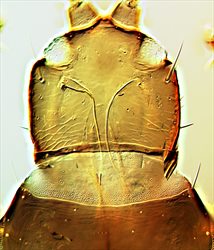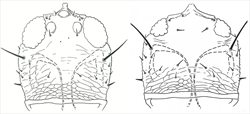
Female aptera head

Heads of female macroptera and aptera

Female aptera antenna

Female macroptera antenna

Antenna female aptera, and segments IV-V of macroptera

Pelta & tergite I
Females fully winged, but females and males also apterous. Body and femora of macropterae light brown, tarsi and tibiae yellow; antennal segment III partly yellow; fore wings pale; apterae largely yellow with tube brown and shadings medially on tergites. Antennae 8-segmented; segment III with 2 (or 3) sense cones, IV with 2 (or 3–4) sense cones; ventrally IV–VI with variable number of small sensory hairs (up to 25 on IV); VIII only weakly narrowed to base. Head slightly longer than wide, wider across cheeks than across eyes, cheeks slightly constricted at base, with one pair of small setae; postocular setae bluntly pointed in macropterae; apterae with eyes small, postocular setae long and finely pointed; maxillary stylets retracted to postocular setae, close together medially in apterae but about one fifth of head width apart in macropterae. Pronotum without sculpture medially; with 4 pairs of pointed major setae, anteromarginal setae small; prosternal basantra absent. Fore tarsal tooth small in macropterae, large in apterae. Metanotum without sculpture medially. Forewing parallel sided, with 8–10 duplicated cilia. Abdominal tergites II–VII with two pairs of curved wing-retaining setae, these are small and straight in apterae; marginal setae S1 long and pointed; tergite IX setae S1 pointed, more than half as long as tube.
Male apterous with small eyes and no ocelli; large males with fore femora swollen and tarsal tooth large; tergite IX setae S2 about half as long as S1; sternites IV–VII with reticulate areas laterally, VIII with irregular transverse pore plate not extending full width of sternite.
The genus Hoplothrips includes about 120 named species, but there are no modern identification keys to any substantial number of species. The most common species are known to exist as both winged and wingless morphs. Moreover, these species exhibit considerable sexual dimorphism, and males of the same species vary in body size, with some structures exhibiting patterns of allometric growth. As a result, species identification is often difficult (Mound & Walker, 1986; Kobro & Rafoss, 2006; Okajima, 2006). Hoplothrips semicaecus is unusual within the genus in having several, sometimes many, small sensory hairs ventrally on antennal segments IV–VI. These are more numerous in macropterae than in the commonly collected apterae.
Breeding on dead branches of various Angiosperm trees, and presumably feeding on fungal hyphae.
In Britain, known primarily from southern England and East Anglia, but also from Yorkshire and Durham (Mound et al., 1976; Collins, 2011). Recorded widely across central and western Europe, also from Bulgaria, and also from North America, Japan and New Zealand. Mound & Walker (1986) gave reasons for suggesting that this species may have been distributed from New Zealand by 19th century shipping.
PHLAEOTHRIPIDAE - PHLAEOTHRIPINAE
Hoplothrips semicaecus (Uzel)
Trichothrips semicaeca Uzel, 1895: 249
Trichothrips amabilis Bagnall, 1926: 283
Hoplothrips (Trichothrips) fieldsi Crawford JC, 1939: 77
Collins DW (2011) The Thysanoptera of Thorne and Hatfield Moors. Thorne and Hatfield Moors Papers 8: 79–85.
Kobro S & Rafoss T (2006) Identification of adult males and females of Hoplothrips species (Thysanoptera: Tubulifera) known from Norway, and some deductions on their life history. Entomologica Fennica 17: 184–192.
Mound LA, Morison GD, Pitkin BR & Palmer JM (1976) Thysanoptera. Handbooks for the Identification of British Insects 1 (11): 1–79.
Mound LA & Walker AK (1986) Tubulifera (Insecta: Thysanoptera). Fauna of New Zealand 10: 1–140.
Okajima S (2006) The Suborder Tubulifera (Thysanoptera). The Insects of Japan 2: 1–720.